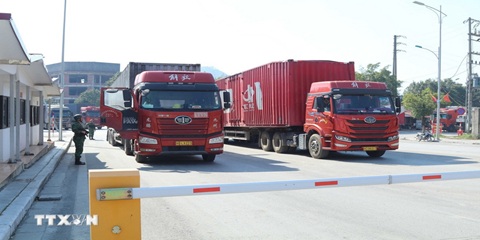Want to be in the loop?
subscribe to
our notification
Business News
MULTINATIONALS KEEN TO THRASH OUT GLOBAL TAX ARRANGEMENTS
Multinational enterprises are willing to pay the global minimum tax in Vietnam, but the calculation and implementation of top-up fees may cause a headache.
At last week’s international workshop on implementing Pillar 2 of the global minimum tax (GMT) in Vietnam, Dong Thi Hong Anh, chief accountant of its Vietnam operations, said tech giant Samsung stands ready to pay more taxes in Vietnam in line with the GMT roadmap.
“Samsung has been aware of the GMT since its early days, and is eager to gain insights into the Vietnamese government’s support for businesses in line with its implementation,” she said at the event, hosted by the Vietnam Association of Foreign Invested Enterprises and the Washington-based International Tax and Investment Centre (ITIC).
Samsung Electronics Vietnam – the country’s largest foreign investor – posted revenues of about $75 billion in 2023, accounting for nearly 20 per cent of Vietnam’s export turnover, creating jobs for nearly 200,000 direct workers and millions of indirect workers. It plans to rapidly ramp up investment in IT and semiconductors, and hopes the government to ensure fair and equitable benefits for the company.
At a seminar organised by the National Assembly’s Committee for Finance and Budget, CEO of Samsung Electronics Vietnam said that the company paid 2023 corporate income tax at a 6.9 per cent rate. If the tax rate increases to 15 per cent, it will have to pay an additional $650 million.
The CEO has proposed the government refund it $100 million for technological innovation, $150 million for research and development, and $100 million for matching with Vietnamese businesses. This would be equivalent to half of the top-up tax.
Intel representative Do Thi Thu Huong expressed similar sentiments at last week’s workshop. “As Vietnam is drafting detailed legislation on implementing the GMT and providing support for businesses, Intel looks forward to cooperating with the government on this issue,” she said.
In another case, at the end of February, LG Chem is expected to be obliged to pay an additional $112 million to the South Korean government. The company holds more than 80 per cent shares of LG Energy Solution, which is expected to benefit from about $1.5 billion in tax incentives in the United States under the Inflation Reduction Act. A representative of this company said that LG Chem’s paying additional taxes or not depends on its decision to sell its shares in the subsidiary.
According to the GMT’s Pillar 2, a multinational corporation (MNC) whose revenue stated in the consolidated financial statements of the ultimate parent entity for at least two years in the four immediately preceding years to the taxable year is equivalent to €750 million (approximately $800 million) or more is subject to the GMT. All countries can apply the GMT to the ultimate parent entity of MNCs in their jurisdiction, even when the MNCs do not meet the revenue threshold.
The GMT is applied on a country-by-country basis. The computation of the effective tax rate, excess profits tax, and top-up tax will be based on all the constituent entities of the MNC in each country.
The General Department of Taxation raised an example that Samsung Group has seven constituent entities in Vietnam, then the effective tax rate, excess profits tax, and top-up tax of Samsung Group in Vietnam will be computed based on aggregate income or losses of the entities.
If Vietnam’s Group A has investments in Cambodia (with three constituent entities) and Laos (four constituent entities), the top-up tax on Group A will be computed separately in Cambodia based on three constituent entities in Cambodia and separately in Laos on the basis of four constituent entities in Laos.
Jonathan Pemberton, senior advisor with the ITIC, said that some countries could be tempted to fiddle and offer tax incentives or simplify the rules, but that it would not work. MNCs expect consistency in tax filings, so competent authorities should engage and support each other to help them.
Payment of the top-up tax is ensured by three interlocking rules, including the income inclusion rule, the qualified domestic minimum top-up tax, and the undertaxed profits rule.
“A common tax base is essential if the Global Anti-Base Erosion rules are to achieve their objective of minimum taxation of all profits globally, with no duplication and no gaps,” Pemberton said. “The starting point is the profit, or loss, of each constituent entity of the MNC as determined for the Consolidated Financial Statements of the ultimate parent entity prepared according to accepted accounting standards.”
Pillar 2 liabilities computations are based on a distinct set of rules, so filing and reporting will take place in parallel with corporate income tax obligations. However, compliance and risk assessment processes for large MNCs will need to be coordinated. Many of the potential risk areas are the same: both Pillar 2 and corporate income tax are predicated on compliance with the arm’s length principle, the expert said.
Countries that have outbound investments will mostly apply the GMT from 2024 to collect the difference between the effective tax rate and the GMT (15 per cent), including the economies that are large investors in Vietnam such as South Korea, Japan, Singapore, and Hong Kong.
Residence countries like Vietnam are working on policies to respond to the GMT, including applying the qualified domestic minimum top-up tax to prevent top-up taxes on the income of constituent entities that enjoy effective tax rates lower than the minimum level from going to countries where the parent company is headquartered. At the same time, they are also studying a number of financial incentives to retain foreign-invested enterprises subject to the GMT and draw in new foreign investors.
Source: VIR
Related News

VIETNAM’S SEAFOOD EXPORTS HIT OVER US$10 BILLION IN JAN-NOV
Seafood export revenue in November alone amounted to nearly US$990 million, up 6.6% year-on-year. Key product groups posted solid gains. Shrimp exports rose 11.7% to over US$385 million, supported by strong demand for whiteleg shrimp and lobster. Tra fish shipments increased 9.7% to almost US$197 million, while marine fish, squid, and mollusk exports maintained their recovery.

VIETNAM’S AGRO-FORESTRY-FISHERY EXPORTS HIT NEW RECORD IN JAN-NOV
Vietnam’s agro-forestry-fishery export revenue reached an estimated US$64.01 billion in the first 11 months of 2025, up 12.6% year-on-year and surpassing the full-year record of US$62.4 billion set in 2024. Agricultural exports reached US$34.24 billion, up 15% year-on-year, while livestock products brought in US$567.4 million, a 16.8% increase. Seafood exports rose 13.2% to US$10.38 billion, and forestry products earned US$16.61 billion, up 5.9%.

HANOI REPORTS RECORD-HIGH BUDGET REVENUE IN 2025
Hanoi’s budget revenue is estimated to reach VND641.7 trillion in 2025, the highest level ever recorded and nearly 25% above the revised target, according to a report by the municipal government. Data from the city’s socioeconomic performance review shows that total state budget collections in 2025 are projected to reach 124.9% of the adjusted plan and rise 24.9% from 2024, the Vietnam News Agency reported.

VIETNAM, CHINA TO PILOT TWO-WAY CARGO TRANSPORT AT LANG SON BORDER
Vietnam and China will launch a one-year pilot program on December 10 to allow two-way cargo transport through the Huu Nghi–Youyi Guan international border gates in Lang Son Province, reported the Vietnam News Agency. The Dong Dang-Lang Son Economic Zone Management Board said the trial aims to reduce transport costs and improve customs clearance capacity.

VIETNAM’S IMPORT-EXPORT VALUE NEARS US$840 BILLION IN JAN-NOV
The total value of Vietnam’s imports and exports was nearly US$840 billion between January and November this year, the highest level ever recorded, according to the National Statistics Office. In its latest report on the country’s socio-economic performance, the National Statistics Office highlighted a series of positive economic indicators, with trade emerging as one of the strongest drivers of growth.

OVER 19 MILLION INTERNATIONAL VISITORS COME TO VIETNAM IN JAN-NOV
Vietnam received more than 19.1 million international visitors in the first 11 months of 2025, a 20.9% increase year-on-year and the highest level ever recorded, according to the National Statistics Office. The figure surpasses the full-year record of 18 million arrivals set in 2019, before the Covid-19 pandemic. Nearly two million foreign visitors arrived in November alone, up 14.2% from October and 15.6% from the same period last year.
























